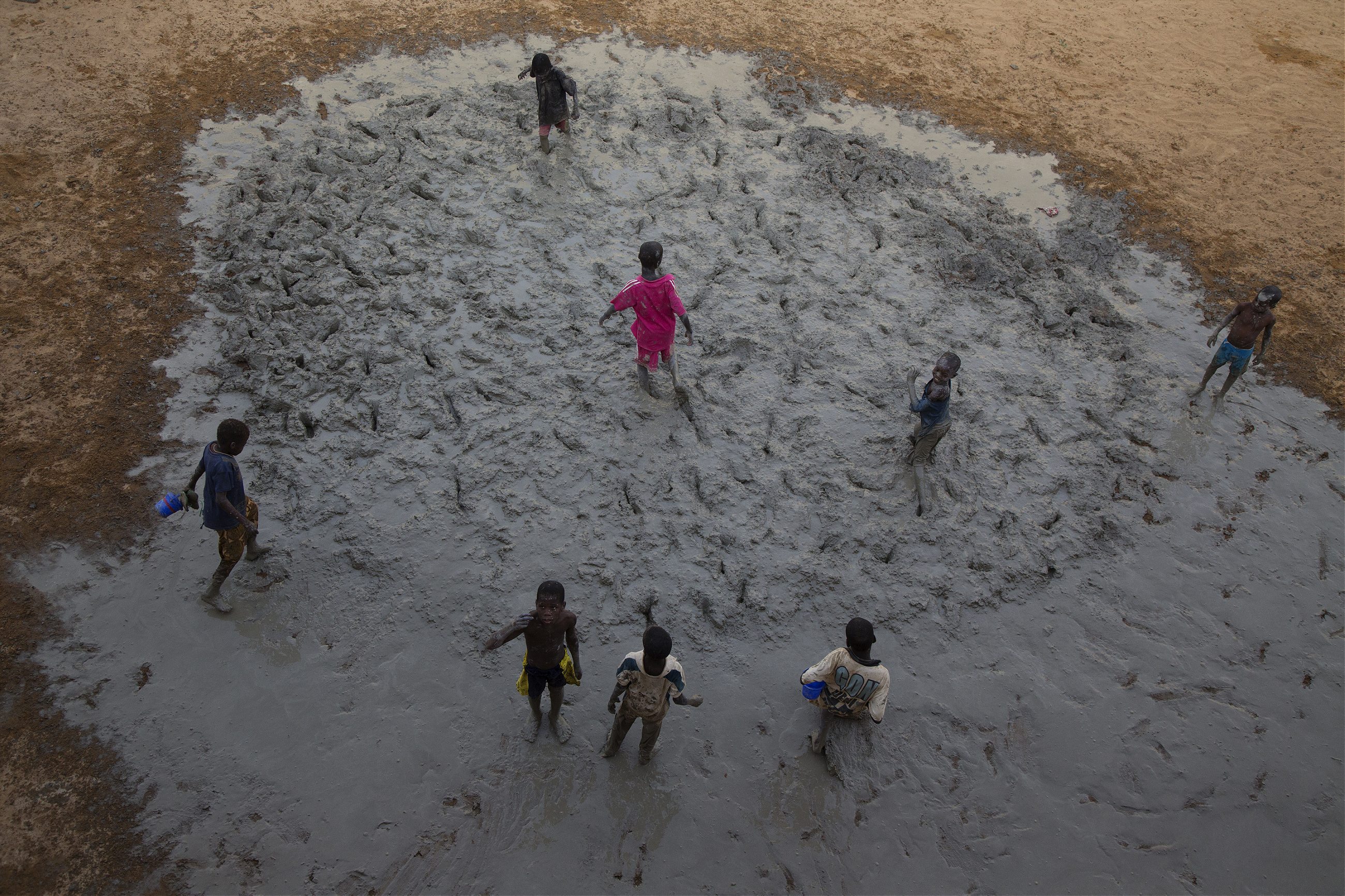As militant attacks get closer, the Malian town of Djenné defiantly continues its annual tradition of replastering its ancient mud mosque.
The evening before the crépissage, the annual replastering of Djenné’s Great Mosque, Balphady Yaro is throwing a party for his friends and neighbors in the town’s Konofia neighborhood.
Rickety plastic chairs and tables line the winding streets around Djenné’s main square, where the mosque looms over the town’s low, mud-brick houses. There are plates of riz au gras—tasty rice with meat and vegetables—and chilled soft drinks. Ivorian coupé-decalé music reverberates on soft mud walls.
Djenné, a town of about 35,000 in the central region of Mali, is famous for its traditional mud-brick architecture and its UNESCO-protected mosque. Fifty-two feet high and built on a 300-foot long platform to protect it from flooding, the mosque is the world’s largest mud-brick building. Touching up its walls each year—called the crépissage, the French word for plastering—is a proud and exuberant ritual that involves the whole town.
(Related: These stunning images show people coming together to repair an iconic mosque)
“The crépissage is the most important event of the year, even bigger than Eid-al-fitr, marking the end of Ramadan, or Tabaski, [the Malian equivalent of Christmas],” says Yaro, the 30-year old lawyer and host of the celebration, known as la nuit de veille.
Sitting under a tarpaulin strung between two neem trees, Yaro watches as the crowds sway through the street. The partygoers won’t sleep until after the crépissage. The revelry will strengthen them ahead of tomorrow’s big task, Yaro claims, sipping a soft drink. “Tonight we party, and tomorrow we will celebrate our mosque and Djenné’s cultural heritage.”
The residents of Djenné come together to put a new layer of clay on their mosque every April, just before the rainy season. The crépissage is both a necessary maintenance task to prevent the mosque’s walls from drying out and crumbling, and an elaborate festival that celebrates Djenné’s heritage, faith, and community. But this year, it’s also an act of defiance.
The increasing instability in Mali’s central region—fueled by inter-tribal conflicts and growing numbers of militant and jihadist groups exploiting the absence of state security forces—now threatens Djenné and its sacred annual ritual. Local militants, some linked to with the Group for the Support of Islam and Muslims (JNIM)—formed by the 2017 merger of several extremist groups operating in Mali—have invaded towns, destroyed markets, and spread their influence in central Mali.
So far, Djenné and its mosque have been spared, but the security situation in the region continues to deteriorate, and more frequent attacks are being carried out in Djenné’s orbit.
“We knew that the militants were getting closer to Djenné,’ says town chief Sidi Yéya Maiga, at his home the day before the crépissage. In fact, this year the town council took the extraordinary step of debating whether or not to cancel their cherished tradition.
But in an act of collective resistance, they decided the show must go on.
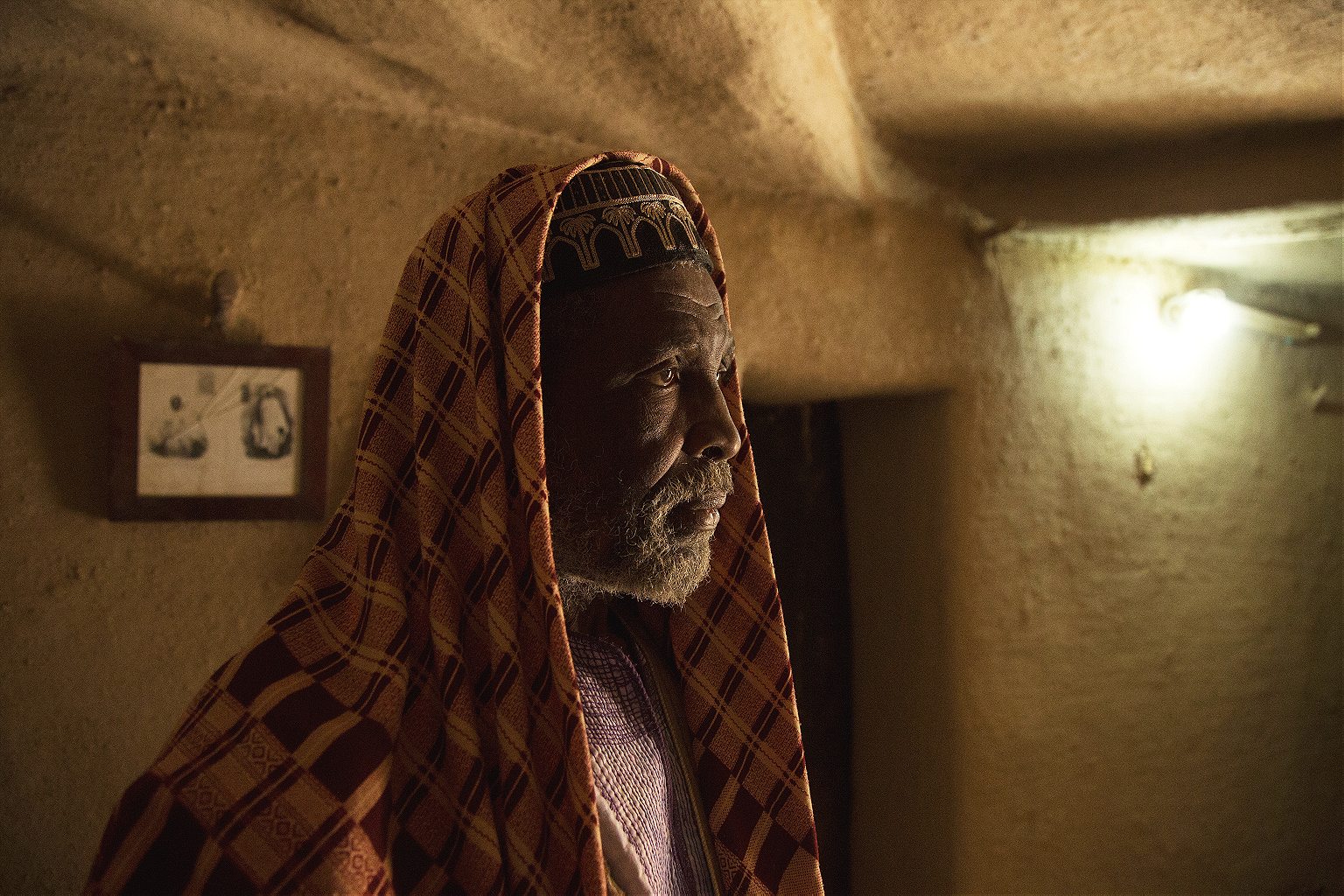
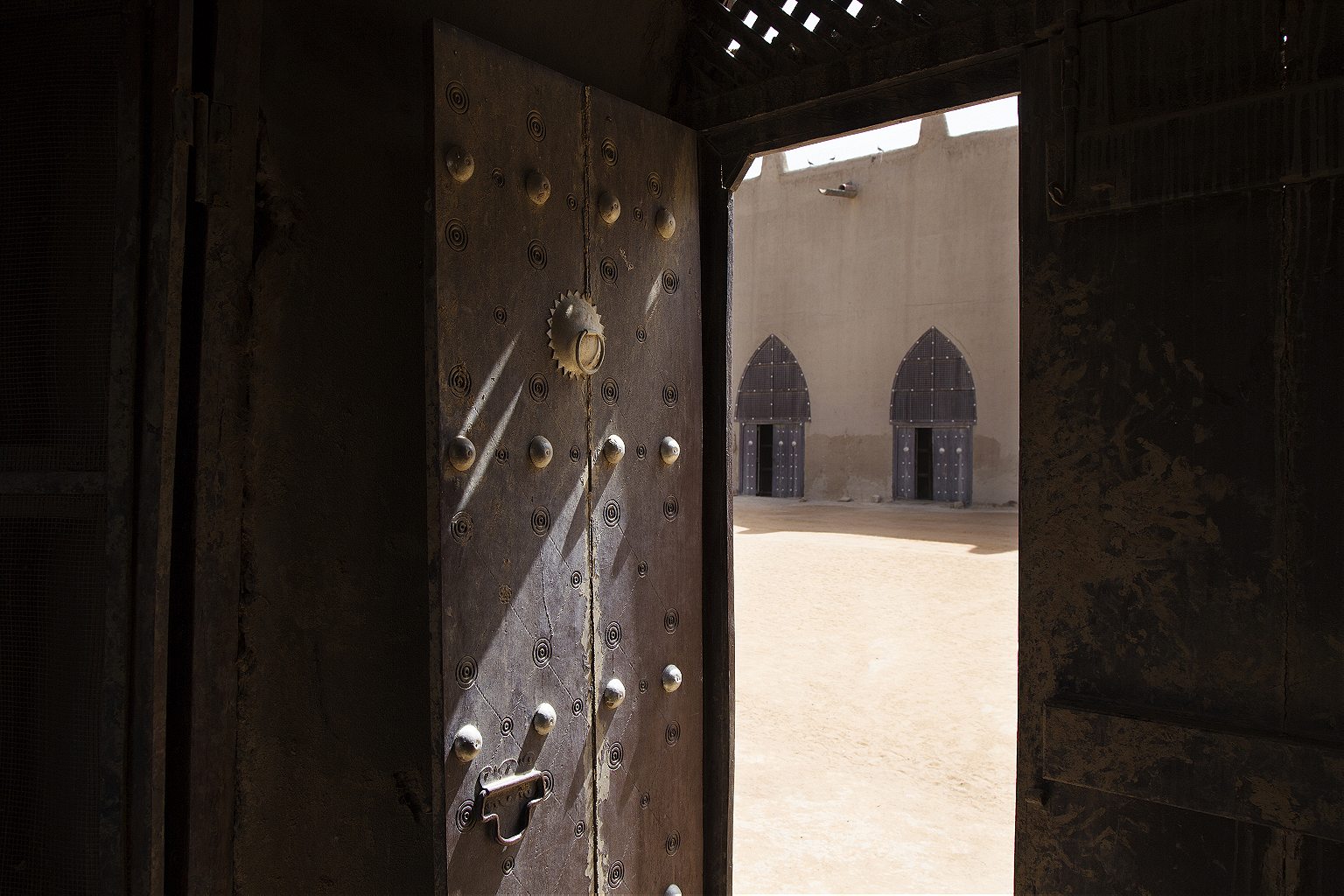
Djenné’s Great Mosque is a magnificent, surreal, castle-like structure. (French journalist and explorer Felix Dubois, writing in 1911, described it as a cross between a hedgehog and a church organ.) It’s constructed almost entirely from mud-brick coated in layers of clay, or banco: clay mixed with water and rice husks. It was first built around the 13th century, but had crumbled into ruins by the 19th century and was rebuilt in 1907. It’s considered one of the finest examples of Sudano-Sahelian architecture; both the mosque and the town around it are UNESCO World Heritage sites.
The mosque has three distinctive minarets, and rows of wooden poles sticking out of its walls like toothpicks. The poles, made from palm trees from the nearby Macina forest, function as a permanent scaffolding that allows people to climb the walls to do the restorative mud-work. Mali’s hot and dry climate, punctuated with stretches of torrential rain, is tough on mud, quickly causing leaks and fissures. Like the mosque, Djenné’s mud-brick houses need a yearly touch-up.
“Without the new layer of banco, the mosque would crumble, just like our homes,” says Yaro.
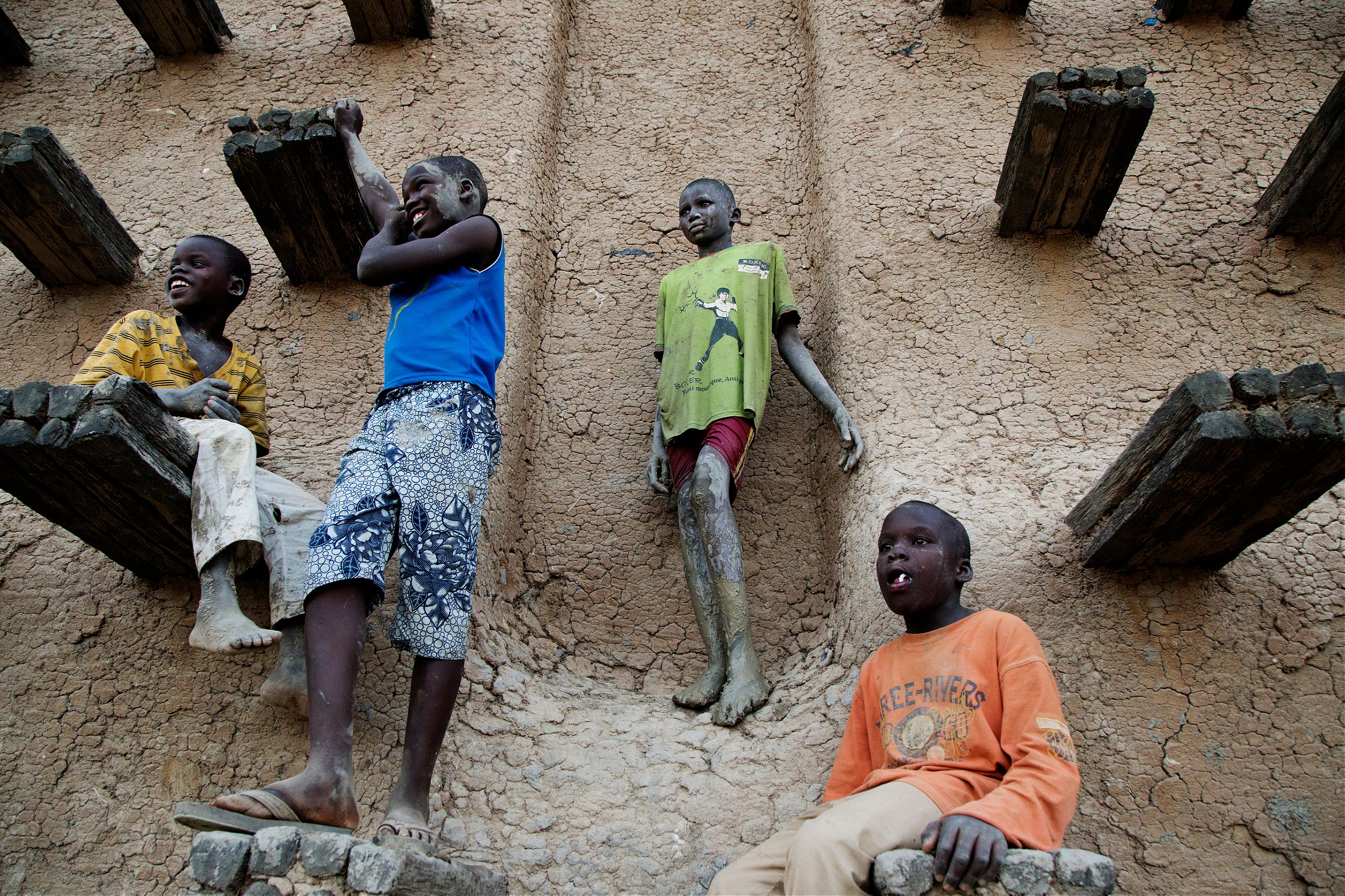
Djenné, on the edge of the Sahel region, a vast expanse of arid, sparsely populated brushland, is only reachable by ferry across the Bani river. There is no tarmac in town; all the streets are covered in sand, which the wind frequently carries into peoples’ homes.
“I’m constantly sweeping my house,” says Nouhoum Touré, one of Djenné’s 250 masons. Like his father Bakary Touré before him, he is head of the mason’s guild. The dry weeks before the rainy season, when many people in Djenné replaster their homes, is Touré’s busiest time of the year.
On the day before the crépissage, he heads down to the riverbank to check on the mud that has been left to soak for 20 days. It’s the height of the dry season, and the river has shrunk to shallow puddles and inlets. The round pools, where store the clay until it’s time for the crépissage, look like pockmarks on the riverbed.
The mud comes from further down the river and is transported here by trucks and donkey carts. Younger masons then break the blocks into smaller chunks and mix them with water. In the final stages, rice husks are added to the mud, turning it into a soft and sticky paste. The rice works like a glue, holding the mud together and keeping it from cracking as it dries. Then the young masons carry the mixture, in wicker baskets, to pits in front of the mosque in preparation for the event.
Touré crouches next to one of the pools and dips his fingers into the shiny, dark banco and rolls it between his fingers, forming it into a ball.
“Part of being a good mason is to be able to tell when the banco is ready just by feeling the texture,” he says. “I feel the softness and the plasticity.”
He wipes his fingers free from mud on his dark green boubou—the long, loose-fitting traditional garment worn in West Africa.
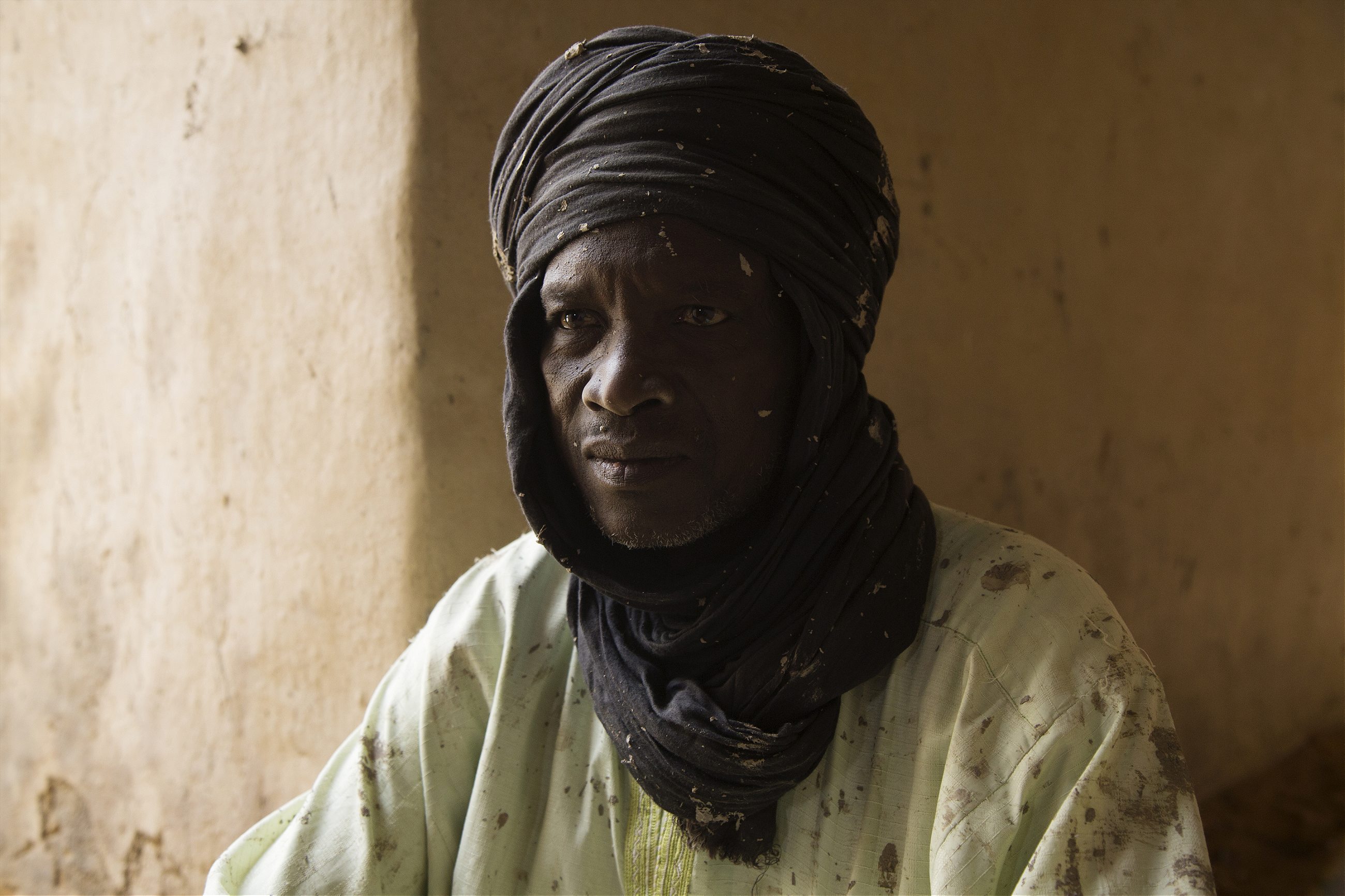
Perhaps it was the town’s sheltered position, on an island between the banks of the Bani and Niger rivers, that spared Djenné and its mosque from the 2012 Islamist incursion. After a military coup left a power vacuum in Mali’s north, al-Qaeda in the Islamic Maghreb (AQIM) and its allies, Ansar Dine and The Movement for Oneness and Jihad in West Africa (MUJAO) seized control of the north of the country and declared it a caliphate. (They were dislodged, but far from defeated, with help from French and African Union forces shortly after.)
But some believe there is a further explanation. Djenné, for centuries an important stop on Saharan trade routes, played a pivotal role in spreading Islam in Africa. The mosque, and Djenné’s revered religious leaders, called marabouts, have legendary status in the region. In 2012, when AQIM and its affiliates destroyed ancient mausoleums in Timbuktu, 300 miles to the north, the marabouts gathered in the shade of the mosque to pray for the town. According to lore, the marabouts cast a spell around Djenné to protect it.
When I speak to the mosque’s guardian, Yaya Nientao, a tall, lanky man in a beige boubou, he suggests that the marabouts’ spells have kept militant groups away. “The marabouts are indeed very powerful,” he says, standing underneath the mosque’s grand ceiling, which is supported by 100 large pillars.
In the village of Koro, 100 miles to the east of Djenné, many people no longer dare to go to the market.
The spell seems to be holding, for now. But the chaos is closing in. Mali’s north has long been volatile, with a Tuareg separatist movement and several armed insurgencies challenging the government for territory. There are regular attacks on hotels, markets, and UN peacekeeping forces. But thanks in part to the state’s neglect of the area, violence is now escalating in Mali’s central region. Deadly clashes between different ethnic groups over resources in central Mali, particularly in the Mopti region where Djenné is located, have become more frequent. Militant jihadist groups have expanded their geographic reach and exploited the lack of security forces to spread their influence.
In March 2018, two dozen armed men on motorbikes, suspected to be jihadists, destroyed the construction site of an almost-completed dam near Djenné. Later in March, an attack on Hotel Falasie in the town of Bandiagara, about 100 miles from Djenné, killed at least one person. (No group claimed responsibility for the hotel attack.) But JNIM, and in particular its member group the Macina Liberation Front, have claimed responsibility for a series of attacks in Mali, many of them in the central region.
Across the Niger river from Bandiagara, jihadists’ attacks and threats have caused schools to close down. In the village of Koro, 100 miles to the east of Djenné, many people no longer dare to go to the market. Local militants have robbed people on the road as they’ve returned from the market, and turned up at Friday prayers demanding that people follow ‘‘rules,” such as women covering up.
In the months and weeks leading up to the crépissage, Maiga, Djenné’s village chief, received several warnings from people advising him to postpone it. So he gathered the Djenné’s eleven neighborhood councilors and asked them if they thought it was safe to go through with the crépissage.
“The question I wanted answered was if the armed men, these bandits, posed an actual threat to the mosque and the townspeople,” says Maiga.
As the council debated, Maiga contemplated their options. Ultimately, they felt there was only one correct course of action. After careful deliberation, the council decided to hold the festival. By allowing the crépissage to go ahead, says Maiga, the town is sending a clear message to the militants.
“I knew that if we postponed the crépissage, it would be seen as giving in to the terrorists,” says Maiga.


It’s well after midnight in Konofia, but Balphady Yaro’s party is only getting started. It will continue until just after 4 a.m. when the muezzin will call the revelers to the mosque.
“Partying all night will make them climb even higher during the crépissage,” says Yaro.
Putting a new layer of banco on the mosque wall is a race to the top between the town’s eleven neighborhoods, with young men using the wooden poles on the mosque walls to replaster as they climb up towards the mosque’s rounded minarets. As Yaro says, grinning: “Just like in life, everyone wants to end up on top.”
During the crépissage, each neighborhood has a section of the mosque to replaster, and the fastest team to re-mud their section of the mosque wins. Konofia’s residents have chosen Yaro to be their emir: the person who spurs them on as they compete. Tomorrow, the pressure will be on for Yaro to lead Konofia to victory.
His opponent will be the emir of the densely populated Yoboucaïna, the neighborhood of winding streets behind the mosque.
In one the corner of the party, a humming generator powers a spotlight directed at the VIP table, where Yaro’s worthy opponent, the Yoboucaïna emir, Djelika Kantao, sits under a banner that reads “Djenneka Raws”, the name the neighborhood has chosen for its team.
During the crépissage, she’ll lead the young girls of Yoboucaïna to the river, where they’ll collect water to mix with the clay to prevent it from drying in the sun. It’s the one day a year when women are allowed into the mosque.
“Just to participate in the crépissage is an honor,” says Kantao, her carefully pleated hair draped in waves over her forehead.
“You need to be strong, fast and determined to endure the pain carrying buckets of water from the river,” she says. “Yoboucaïna is one of the largest and strongest neighborhoods. We have many strong men and women. I’m confident we will win.”
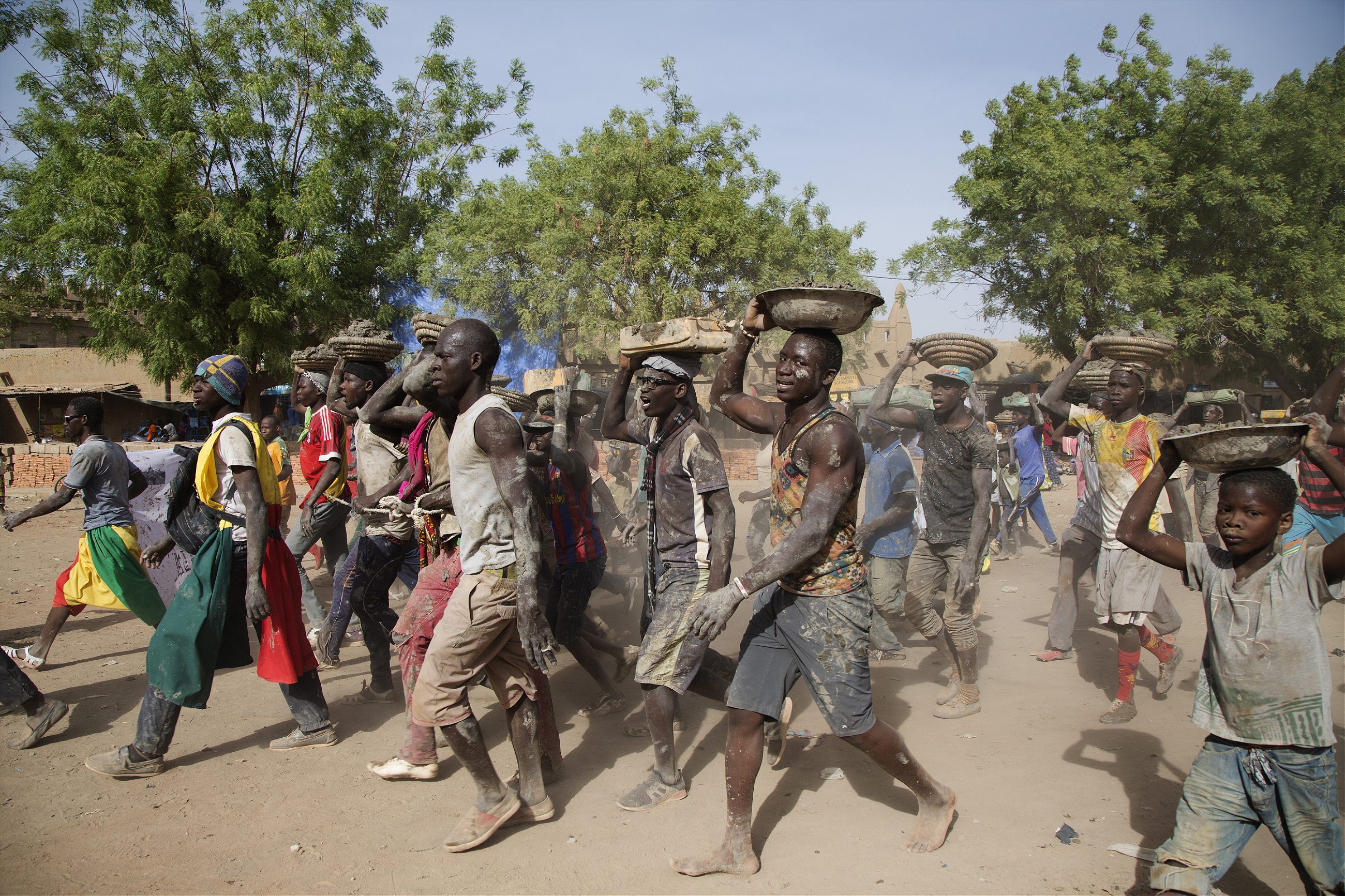
Early in the morning on the long-awaited day of the crépissage, Djenné’s residents gather by the mosque and wait for Touré, the master mason, to smear the first blob of mud on the wall. This is the starting gun.
There is a roar from the crowd as dozens of young men—some masons, some apprentices—run to the mosque. Smaller groups of boys raise wooden ladders against the mosque wall.
The young men, carrying wicker baskets full of dripping-wet clay from the pits next to the mosque, begin scrambling up the façade, using the ladders to reach the wooden poles protruding from the walls. Perching perilously on the wooden scaffolding, they pick up large blobs of clay and smear them on the wall.
Nientao, the mosque’s guardian, weaves through the crowd, his pockets filled with sweets for the workers. Thousands of muddy feet trample the paths around the mosque. As the sun begins to rise over Djenné, turning shapeless shadows into dark silhouettes, a group of boys and masons attack the minarets from the roof of the mosque.
Four hours later, the morning sun shines on the newly plastered mosque. Dark, wet clay patches on the dried mud give it a sickly look.
Touré is covered in mud all way way from his plastic sandals, which have miraculously stayed on his feet, to the top of his turban. “I think we did very well,” he says, sitting in the shade of the mosque. “Normally, we re-mud the mosque over two days. This time we managed to get it done in only one day.”
A little later, there is a crack as the loudspeakers come on, then the sound of Djenné’s mayor, Balfine Yaro (no relation to Balphady), clearing his throat. Everyone looks on in silence as he makes his way to the front of the crowd. He declares Djenneka Raws the winning team. Djelika Kantao and Yoboucaïna have prevailed. For the winners there is pride, honor, and a cash prize of 50,000 West African francs, or about US$90.
“With the money,” says Kantao, beaming with pride, “I will buy new solar panels for the neighborhood, so we no longer have to live in darkness.”
